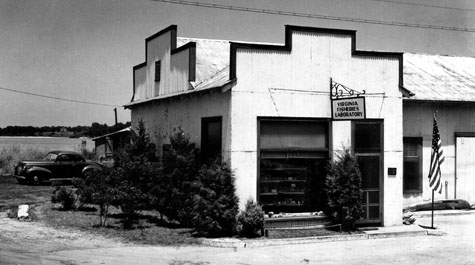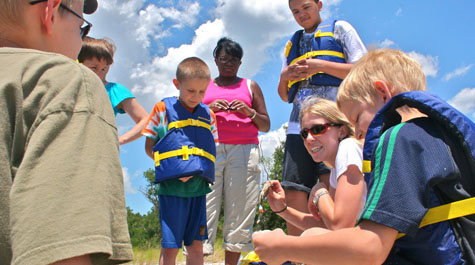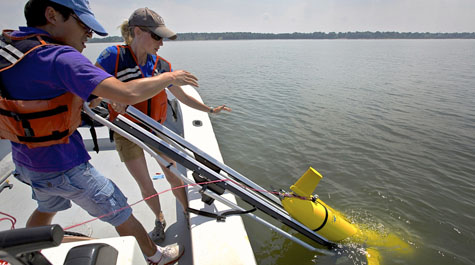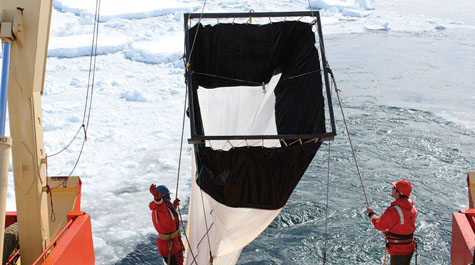VIMS voyage: celebrating 75 years
This story originally appeared in the spring 2015 issue of the W&M Alumni Magazine. - Ed.
It all began in old gas station in Yorktown. That humble building housed the first incarnation of William & Mary's Virginia Institute of Marine Science — the Virginia Fisheries Laboratory (VFL), which opened its doors in 1940.
The man responsible for bringing marine science to William & Mary was Donald W. Davis, chair of the university’s Biology Department. Starting with a paper published in Science a decade earlier, “How the College Can Aid the Oyster Industries,” he argued that research and education should be separate from the Commonwealth’s marine regulatory activities.
Hampton, Virginia, seafood producer Richard Armstrong was among industry leaders who endorsed Davis’ “separation theory,” calling it “a plan that would assure permanent and non-political interest in the development of our sea foods.”
With the successful establishment of the VFL and its graduate program in aquatic science, Davis laid the foundation for VIMS’ tripartite mission of research, education and advisory service — a mission that has made it unique among marine science institutions. VIMS’ role as official advisor to the state is now mandated in more than 30 different sections of the Virginia Code.
Today, VIMS is an international leader in coastal and estuarine science headquartered on a 42-acre campus in Gloucester Point, Va. “The majority of our work is centered in Chesapeake Bay, its watershed and the coastal ocean off of Virginia,” said VIMS Dean and Director John Wells. “But a lot of what we do outside that area brings knowledge and understanding to bear on Virginia. Likewise, what we do here in Chesapeake Bay is transportable to lots of other troubled ecosystems around the world.”
For 75 years, VIMS has been collecting, analyzing, synthesizing and sharing millions of pieces of data on everything from water quality to fish populations, creating a one-of-a-kind, comprehensive picture of the Bay’s complex ecosystem — with real-life impact far beyond Virginia. These data will be critical in predicting future conditions as we face accelerating global environmental change.
Whether wading in Bay shallows or exploring 20,000 feet below Antarctic seas, VIMS faculty and alumni can be found throughout the world. Here are just a few of their stories.
Along the River
This past summer, Gov. Terry McAuliffe HON ’14 announced the creation of the Virginia Oyster Trail along the Bay and its tributaries, marking the official comeback of a Chesapeake icon.
The gradual recovery of Crassostrea virginica, decimated by a century of disease, pollution and overharvesting, is one of VIMS’ great success stories. In tandem with decades of work on wild-caught oysters, VIMS has pioneered techniques in oyster aquaculture and operates the most extensive oyster breeding program in the U.S. Shortly after McAuliffe’s announcement, the venerable Atlantic magazine showcased the work of Professor Stan Allen — director of VIMS’ Aquaculture Genetics and Breeding Technology Center — in developing the disease-tolerant triploid oyster.
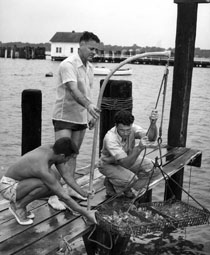 “We are probably the world’s leader in terms of research, development and training in aquaculture,” Wells said. “We do it really well, and we have strong linkage with industry.” As part of its extensive public outreach programming, VIMS also conducts training for individuals interested in taking up oyster gardening.
“We are probably the world’s leader in terms of research, development and training in aquaculture,” Wells said. “We do it really well, and we have strong linkage with industry.” As part of its extensive public outreach programming, VIMS also conducts training for individuals interested in taking up oyster gardening.
The growing revival of oysters is a boon to other marine species and thus to the entire Virginia seafood industry, now ranked third in the nation behind only Alaska and Louisiana. As filter feeders, oysters improve water quality. And the Bay’s oyster reefs, many wiped out by dredging and mining of shells, provide a vital habitat and food source for other marine life.
“The first real change in the way we thought about oyster restoration came in the 1990s, when ecologists started to do research on oyster reefs,” said Professor Mark Luckenbach, VIMS associate dean of research and advisory services. “There started to be an appreciation that these were really important, complex habitats, similar to coral reefs. We’ve been more involved than any other institution in quantifying the ecological functions of oysters.”
Oysters are continuing to prove their worth in new ways. A recent study led by VIMS researcher Lisa Kellogg showed that restored oyster reefs can remove significant levels of nitrogen and phosphorus from fertilizer and wastewater runoff, major contributors to poor water quality in the Bay.
Luckenbach has been at the center of VIMS’ long-term efforts to develop best practices in oyster-reef restoration and management, ranging from substrate composition to seeding techniques. “The solutions to many of these problems no longer come from a single discipline. We bring in molecular biologists, organic chemists — we have numerous amazing physical oceanography modelers.
“I can’t think of a single issue where we don’t have this multidisciplinary approach, from oyster aquaculture to offshore wind development to everything in between. Coupled with our mandate to be the advisor to the state, it’s the single most unique thing about VIMS — this breadth of talent all in one place.”
In the Shallows
Oysters aren’t the only hardworking organism in the Chesapeake. Seagrasses, which grow in the shallow waters of the Bay, its rivers, and coastal lagoons, help to improve water quality and provide critical shelter and nourishment for blue crabs, fish, waterfowl and mammals.
“They’re a ‘canary in the coal mine’ for the Bay,” said Professor Robert “JJ” Orth, leader of VIMS’ Submerged Aquatic Vegetation (SAV) program, which produces an annual interactive map of the Chesapeake’s SAV beds. Because SAV needs sunlight to thrive, its presence in the Bay over the last few decades has plummeted as the waters have become murkier.
Working in the Eastern Shore’s seaside bays in the late 1990s, where eelgrass had disappeared 60 years before, Orth — who earlier pioneered a method to use seeds of eelgrass to restore meadows that have disappeared — achieved success in restoring lost meadows that today is the largest and most successful seagrass restoration project in the world.
“The bays cover thousands and thousands of acres,” Orth said. “Trying to do it the old way of putting in individual plants would have been time- and cost-prohibitive. So we took a little different tack, and said ‘Let’s look at the possibility of using seeds.’
“These are angiosperms, and they basically produce seeds like every angiosperm species in the world, except they do it underwater,” Orth said.
“To make a long story short, it worked.”
With the help of students and private citizens, the SAV program has broadcast more than 50 million eelgrass seeds over 400 acres in the last decade. The restored sites have spread naturally to more than 4,700 acres. Orth and his colleagues are now working with Mark Luckenbach on a program to re-introduce bay scallops, which like eelgrass had been virtually extinct in the seaside bays since the 1930s.
The eelgrass restoration project — a collaboration among state and federal agencies and private foundations — has garnered international attention. VIMS is a partner in a five-year restoration project, NOVAGRASS, funded by the Danish Council for Strategic Research, and is also working with researchers in Australia.
Despite recent successes, Orth warns that eelgrass in particular may be at risk. “We are very near its southern distribution — it doesn’t get below North Carolina,” he said. “We’ve seen a couple years recently where we’ve had abnormally high summer temperatures, and we’ve had major diebacks during that time period.
“The actual recovery of this plant is really going to be tied to what’s happening with the temperatures along the East Coast of the U.S. It’s certainly something that was not in the playbook many years ago.”
And that could spell bad news for already threatened species much higher up in the Bay’s food chain — including the iconic blue crab.
Out on the Bay
Since its founding as the Virginia Fisheries Lab, VIMS has been at the forefront of protecting the Bay’s wide variety of fish — including striped bass, American shad, flounder, Atlantic menhaden and drum — for commercial and recreational anglers alike.
Increasingly, marine scientists at VIMS and elsewhere around the world are taking a multispecies approach to fisheries management, studying how fish interact with each other and their environment by looking at seasonal changes in distribution, water-quality factors and predator-prey dynamics — or “who’s eating whom in Chesapeake Bay,” as recent alumnus Andre Buchheister M.S. ’08, Ph.D. ’14 puts it.
As a graduate student, Buchheister was the lead author of a study that used 10 years of monitoring data to show for the first time on a Bay-wide scale that so-called “dead zones” — areas of low oxygen abetted by excess nutrient runoff — are impacting the distribution and abundance of fish that live and feed near the Bay’s bottom. Buchheister was the most recent of five VIMS students to receive W&M’s Thatcher Prize for Graduate and Professional Excellence.
While at VIMS, Buchheister also taught a course for W&M undergraduates in the marine science minor. “It made me realize how much I’d learned through grad school, but it also challenged me to keep learning more, with all the insights that the undergraduates brought to the table.”
For all of VIMS’ 75 years, graduate students like Buchheister have been working alongside faculty members. “What really stood out for me about VIMS was the way faculty treated students as colleagues, particularly my adviser, Rob Latour,” Buchheister said. “He helped guide me and bestowed his wisdom on me, but it was a mutual learning process in some regards. Working together to answer questions of pertinence — that’s something I really valued.”
“We have a really rich training ground for graduate students,” said Professor Linda Schaffner M.S. ’80, Ph.D. ’87, VIMS associate dean of academic studies, who notes that VIMS has been the second-highest producer of marine science Ph.D.s in the nation during the last 20 years. “They’re all doing basic research, but thinking about the real-world context every day. The minute these students graduate, they’re snapped up for a job.”
VIMS’ educational activities involve thousands of elementary and secondary school students as well. The GK-12 PERFECT project funded by the National Science Foundation, for example, pairs VIMS graduate students and public school teachers to provide STEM curricula in the classroom.
“I think the linkage between VIMS and the main campus has really benefited faculty and students here, by keeping excellence in education at the forefront,” Schaffner said.
At Ocean’s Edge
Looking out from the 18-mile Chesapeake Bay Bridge-Tunnel toward the Atlantic, it’s easy to appreciate the seamless link between Bay and ocean. And as anyone living along the Chesapeake can attest, rising sea levels mean higher waters in the Bay as well. In fact, Virginia is experiencing the highest rates of relative sea-level rise along the Atlantic coast.
“There are three basic reasons,” said Professor Carl Hershner, director of VIMS’ Center for Coastal Resource Management (CCRM). “First, there’s a greater volume of water in the ocean because of melting polar ice caps. Second, we’re sinking. The land here is going down more rapidly than most other places along the coast.
“Last but not least is ocean dynamics,” Hershner added, explaining that slowing of the Gulf Stream decreases the amount of water drawn away from our shores.
Determining how to respond to sea-level rise is a complex political, legal, economic and environmental issue of great urgency. The Organization for Economic Cooperation and Development, an international body, ranks the Hampton Roads region 10th in the world for value of assets at risk, particularly because of the major military presence in the region.
In 2012, the Virginia General Assembly directed VIMS to conduct a comprehensive study of future flooding risks and potential responses. The resulting 150-page report, Recurrent Flooding Study for Tidewater Virginia, reviews adaptation strategies from around the world and proposes the most effective approach for the Commonwealth — a combination of management, accommodation and protection.
“We recommend a hybrid, multi-tiered approach depending on local risk,” said the report’s lead author, Molly Mitchell ’99, M.S. ’03, a CCRM researcher and VIMS doctoral candidate. It can be visualized as a staircase, with each step raising a locality’s resilience to its particular flooding risk.
“Accommodation, for example, means you stay where you are, but you do what you can to reduce the risk,” Mitchell said. She cited early warning systems such as the VIMS Tidewatch website, together with actions like raising home foundations.
The report, which recommended immediate action, resulted in the creation of several state commissions to move forward on planning and legislative measures. The state has recently charged W&M’s Coastal Policy Clinic, a partnership between VIMS, Virginia Sea Grant and the Law School, to review local government’s authority under Virginia law to respond to the challenges that flooding poses.
Hershner, Mitchell and a multidisciplinary team are now working on sophisticated modeling to create scenarios of future sea-level rise in Virginia. “We’re doing a lot of multi-agency coordination,” Hershner said. “We know this information has to be useful for local planners. And to the extent we can do this, there needs to be a consensus not just within the science communities, but also the federal agencies, especially FEMA.”
“And that’s really important when it gets to the planning process, so people aren’t trying to plan for multiple different requirements,” Mitchell added.
“One insight it provides into VIMS is that we are fully engaged in the translation of the science into implementation,” Hershner said. “And the fact that we do this on pretty much all of the issues that we work with, from oyster restoration to wetlands management — that’s the character of VIMS that sets us apart from most other marine institutions.”
On the High Seas
The potential impact of polar ice melt on the mid-Atlantic serves as a powerful reminder that the world’s waters know no boundaries. From the earliest days, VIMS’ scientists have collaborated with other marine researchers on a national and increasingly international level to better understand the interconnectedness of the Earth’s ecosystems.
Fresh off a six-week VIMS expedition in Antarctica aboard the research vessel Laurence M. Gould, CSX Professor Deborah Steinberg discussed her long-term studies on the role of Antarctic zooplankton — tiny sea creatures including krill and salps — in the “biological pump.”
“The biological pump is one of the ways that carbon dioxide gets from the atmosphere into the surface of the ocean and then pumped into the deep ocean, where it stays for hundreds and even thousands of years,” she said.
“Microscopic plants in the surface waters take up carbon dioxide through photosynthesis, just like plants on land do. These plants get eaten by zooplankton, which produce what we call fecal pellets, a fancy word for plankton poop. They’re pretty fast-sinking organic particles. If they sink deep enough, they get the carbon below the threshold where it will be released back into the atmosphere.”
Certain zooplankton also engage in vertical migration, Steinberg added, feeding on the surface and then swimming into the depths, essentially carrying carbon dioxide with them.
Steinberg, who is the seventh VIMS faculty member to receive Virginia’s Outstanding Faculty Award, has been sampling Antarctic zooplankton for several decades, looking at changes in their species composition and how that can affect the biological pump. Over the last 50 years, winter temperatures along the Antarctic Peninsula have increased by 11 degrees Fahrenheit, five times the world average, making the continent a critical barometer of global change.
Each year since 2009, Steinberg has selected a W&M graduate and undergraduate to join her shipboard research team, an initiative supported through the generosity of Adrian Duplantier Jr. and 1st Advantage Federal Credit Union. “The first time I went to Antarctica I was an undergraduate, so for me, it’s really special to be able to do that for others now,” Steinberg said.
For Jack Conroy ’16, it was the experience of a lifetime. “I was astounded over and over again by the scale of the ocean and the continent. Some highlights were seeing a beautiful sunset among icebergs and then a gorgeous sunrise 90 minutes later, and watching Commerson’s dolphins riding the wake of the ship in the Strait of Magellan.”
In addition to getting up-close and personal with zooplankton — which “don’t get enough love for being beautiful animals” — Conroy had the opportunity to meet scientists from around the globe. “These were really kind, caring people who took time to tell me about their own personal paths, and to encourage me to pursue anything and everything that interests me.”
Voyage Through Time
In a 1612 account of his Chesapeake Bay voyages, Captain John Smith wrote: We found in diverse places that aboundance of fish, lying so thicke with their heads above the water, as for want of nets (our barge driving amongst them) we attempted to catch them with a frying pan.
Four centuries later, using rod and reel rather than kitchenware, anglers still enjoy the bounty of the Bay. But stresses both man-made and natural have severely challenged the Chesapeake’s ecosystem, especially during the past century.
For 75 years, VIMS has worked hand-in-hand with industry, state and federal agencies, foundations, public schools and private citizens to restore and safeguard the marine resources of the Bay and beyond. Each challenge has brought a new learning experience.
“We’re very fortunate to have seen a system that is recovering,” said JJ Orth, who has been at VIMS for more than half its 75 years. “In my career, I’ve seen the worst and then I’ve seen the best.”
It’s uncertain what new threats will face the Bay when VIMS reaches 100. What is certain, however, is that VIMS scientists will be there to meet the challenge.
Want to know more? Go to 75th.vims.edu to view videos, historic photos, an interactive timeline and commemorative brochure.
 Skip to main content
Skip to main content

